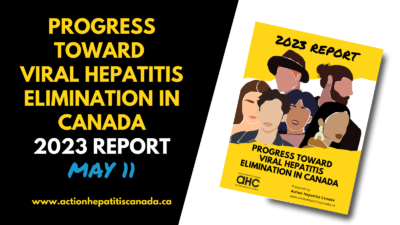Progress toward viral hepatitis elimination in Canada: Holding governments accountable

On May 11, 2023, Action Hepatitis Canada (AHC) released its Progress Toward Viral Hepatitis Elimination in Canada 2023 Report. This is an update on the 2021 report and provides an analysis of each province and territory’s progress toward eliminating viral hepatitis as a public health threat by 2030, a goal set by the World Health Organization (WHO). With a cure for hepatitis C and a vaccine for hepatitis B, this is an ambitious yet realistic goal. Two years after the initial report, we wanted to see what progress had been made in adopting person-centred policies through a health equity lens, as well as how much closer we are to the WHO elimination targets.

Why a progress report?
The Government of Canada has always asserted that provinces and territories are accountable to their citizens for meeting the WHO targets, not the federal government. Since AHC’s mandate is to ensure governments fulfil their responsibilities regarding the 2030 commitment, we developed this progress report as a tool that our many members and allies can use to hold them accountable. By merely monitoring government progress on these types of international commitments, civil society can influence policy-makers to take their commitments more seriously.
The progress report is also an opportunity to provide annual treatment targets for provinces and territories, along with policy recommendations for how to reach them. It includes some background context, a review of the WHO targets, the six metrics used to evaluate progress, an explanation of priority populations, federal recommendations, a new page highlighting national progress, a page for each province and territory measuring progress against each metric and providing specific recommendations, a page for each federal, provincial and territorial correctional system, bright spots, emerging practices in testing and screening, a description of the limitations and data gaps, monitoring and evaluation methodology and references.

Through a health equity lens
As a coalition of community-based organizations, AHC approaches viral hepatitis using a social justice and health equity lens. Viral hepatitis affects a number of populations that have been historically marginalized by mainstream healthcare, creating hurdles to equitable prevention, testing and treatment services. These barriers to achieving viral hepatitis elimination will remain if we do not take a reconciliatory approach to healthcare for Indigenous people, and address inequities in healthcare access for people living in remote and rural areas, as well as for those structurally excluded from mainstream healthcare and society more broadly.
Priority populations
When we use the term priority populations for hepatitis C or viral hepatitis, we are explicitly referring to groups or communities who bear a disproportionate burden of this particular disease. This is not meant to take away from the structural racism, classism, ableism, or additional forms of discrimination that other identities may encounter in accessing viral hepatitis care.
We also recognize that these many identities intersect and overlap, and the harms and risks can be compounded when they do.
In the Blueprint to Inform Hepatitis C Elimination Efforts in Canada, five priority populations and one age cohort are identified:
- People who are incarcerated
- People who use drugs
- Indigenous people
- Gay, bisexual and other men who have sex with men
- Newcomers and immigrants from countries with high prevalence of hepatitis C
- People born between 1945 and 1975
The majority of hepatitis B cases in Canada are among newcomers and immigrants from countries where hepatitis B has high prevalence. Hepatitis B shares many of the same transmission paths as hepatitis C and many of the same priority populations are affected, though the ratios are certainly different.
Six metrics to measure our progress

In designing the progress report, AHC selected six metrics based on the availability of data, as well as the centrality of the target to the overall elimination goals. We updated them for the 2023 report to include hepatitis B metrics and to more closely align with the WHO targets, as these were included in the pan-Canadian framework for action, as well as the Canadian government’s five-year action plan, which was endorsed by all provinces and territories.
Metric 1: New cases of hepatitis C and B
The WHO 2020 target for the decrease in new cases of both hepatitis C and B was 30%.
Metric 2: Elimination plan or strategy
Each jurisdiction must create and implement its own strategy toward viral hepatitis elimination.
Metric 3: Testing for hepatitis C and B
- Hepatitis C RNA or antigen reflex testing implemented?
- Hepatitis C prenatal testing implemented?
- Hepatitis B universal one-time screening for all adults implemented?
Metric 4: Access to hepatitis C and B treatment following diagnosis
- One-day hepatitis C treatment start possible with direct-acting antivirals?
- First-line recommended hepatitis B treatments available without barriers?
Metric 5: Annual hepatitis C treatment prescribing counts
Metric 6: Prevention measures
- Number of needles and syringes distributed – does it meet the WHO 2020 target of 200 distributed for each person who injects drugs?
- Hepatitis B birth dose vaccine implemented?
- Hepatitis B universal adult vaccination recommended and publicly funded?
Additional updates to the progress report design and methodology
In addition to the new metrics and the closer alignment with WHO targets, this report incorporates quotes to add perspectives of people with lived experience, community-based workers and physicians. The metrics used to assess progress within prison systems have also been updated based on our learnings from AHC’s 2022 Prison Health is Public Health report. Finally, there are new pages highlighting national progress and emerging practices in testing and screening.
Current status
Using these metrics, we found that seven out of 10 provinces are on track to meet Canada’s hepatitis C elimination goals, although we did not have enough data to determine the status of the three territories. This does not represent a change from the 2021 progress report, but based on the new metrics, we established that no province or territory is on track to reach its hepatitis B elimination goals.
Data gaps
Prevalence
While Canada has internationally recognized hepatitis C epidemiological research outputs, tracking prevalence at the provincial and territorial level is still challenging. As a result, it was difficult to determine what the annual hepatitis C treatment initiation target for each province and territory should be. Furthermore, there are no published provincial or territorial hepatitis B prevalence estimates that we could find. These need to be updated urgently for all provinces and territories, along with prevalence estimates for hepatitis C.
Estimates of people who inject drugs
Provinces and territories endorsed the WHO’s target of distributing 200 needles or syringes each year for each person who injects drugs. While many jurisdictions track the number of needles distributed, few have an estimate of how many of their residents inject drugs. Without knowing the number of people who could be using them, the number of needles distributed tells us little about our progress toward elimination.
Prescribing counts
In our report, the number of people prescribed hepatitis C treatments is based on data from select pharmacies, which is then modelled to represent an entire province. As a result, it slightly over- and under-estimates the number of patients in different provinces, and for the territories there was no prescribing count data available at all. As the majority of hepatitis C treatments in Canada are covered by publicly funded drug plans, these data should be readily available from the ministries overseeing these taxpayer-supported drug plans. Good data will be key to measuring our progress. How will we know if we have eliminated viral hepatitis in 2030 without accurate data to prove it?
We are grateful for all the input our members and allies provided as we undertook the 2023 report and we hope it will be as well received as the previous one. We also want to offer our thanks to all those who share these reports and use them in their advocacy efforts! As an advocacy tool, the progress report helps unify our message and highlight the need for government action. To reach our elimination targets, governments need to take a health equity approach that does not leave anyone behind.
Download the report to learn more about how your jurisdiction is doing, and what recommendations might be helpful in your own advocacy.
Still have questions, or have research that can help inform our next report in two years’ time? Please email us at actionhepatitiscanada@gmail.com.
Jennifer van Gennip is the executive director for Action Hepatitis Canada, a pan-Canadian coalition providing community accountability on Canada’s commitment to eliminate viral hepatitis as a public health threat by 2030. She lives in Barrie, Ontario, and specializes in advocacy communications for non-profits.
